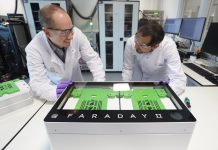
Industrial and commercial (I&C) businesses making investments in energy storage in the hope of making returns from frequency response are “gambling”, according to RedT chief executive Scott McGregor.
McGregor’s firm makes flow storage devices. In simple terms, these provide longer-duration energy output rather than the short duration power bursts that are delivered by the likes of lithium ion or lead acid batteries.
The company is trying to scale its UK operation and McGregor believes successful behind-the-meter I&C energy storage will predominantly be that linked to solar.
Speaking at The Energyst Event, McGregor said he aimed to dispel “misconceptions” about storage as the great white hope of the energy industry.
“There’s some interesting information bandied around the [storage] industry, but I would say 80% is probably rubbish,” said McGregor.
Input and output
“You don’t just buy an energy storage container and make money out of it. It is all about what you put in and take out. Solar going in the top is what makes us money,” he said.
“The second aspect is power price models: In the UK, wholesale prices have been going down over last ten years and will continue to do so. What will go up is power price volatility.”
While grid services are “a nice upside” they cannot be relied upon over the medium term, said McGregor.
“A lot of people have invested in arbitrage and frequency response, which are risky revenues. It is not going to last and revenues will drop off. It is happening now and, to be honest, I call it gambling. If you invest in those assets, those revenues are not locked in and you are at the whim of the market.”
Instead, McGregor believes I&C firms should look at investing energy infrastructure that reduces their bills and makes use of existing assets, such as solar.
“You want to wipe out all of your peak costs … and use the asset as much as you can to reduce your energy bill. It is about energy: cheap generation, storing it and using it when you need it ” he said. “That should give you 80% of your return [on investment],” said McGregor.
“The only guarantee is that policy will be ineffective, create unintended consequences and the market will keep changing,” McGregor added. “So we have to build assets that are flexible and infrastructure-based. Then there will be additional opportunities along the way if you have the right assets.”
The company claims its systems, from 60kW upwards, deliver an internal rate of return (IRR) of around 15% in industrial and commercial applications when used in conjunction with solar,.
Other models
McGregor was asked at the conference whether in front of the meter storage co-located with wind farms is currently viable.
He suggested wind “is not a perfect [co-location] asset, because the wind doesn’t blow all the time and you want to be able to use your storage asset as much as possible”. However, he said “where you put storage centrally across a number of wind assets, I believe that model works.”
Meanwhile, McGregor suggested co-located solar and storage would start to quickly ramp up once solar farms come to the end of their initial PPAs and “excessive” early subsidies.
Hybrid grid-scale storage
McGregor said the company has also started modeling grid-scale storage using flow storage and lithium-ion in tandem. He believes these hybrids, delivering up to 50MW, will enable both capacity-driven services (which require longer duration output) as well as power burst applications, while “extending the life of the battery”.
McGregor later told The Energyst that he believes RedT will “deliver at least one such project in the UK next year”, which will likely be in the region of 10MW.
At a smaller scale, McGregor said “keeping things simple” with flow storage will better suit industrial and commercial applications behind the meter.
“But that doesn’t mean in three or four years time we will not bring out a product that has a rocket-fueled lithium [element], or a super capacitor [alongside the flow machine],” he said.
“If somebody is interested, yes, we will do it [today]. But the question is, are you going to get the return from the additional complexity?”
Related stories:
RedT and Centrica connect 1MWh flow machines in Cornwall
Energy storage ‘will wipe out’ battery storage
Battery storage to push frequency response revenues down STOR’s path?
Follow us at @EnergystMedia. For regular bulletins, sign up for the free newsletter.



